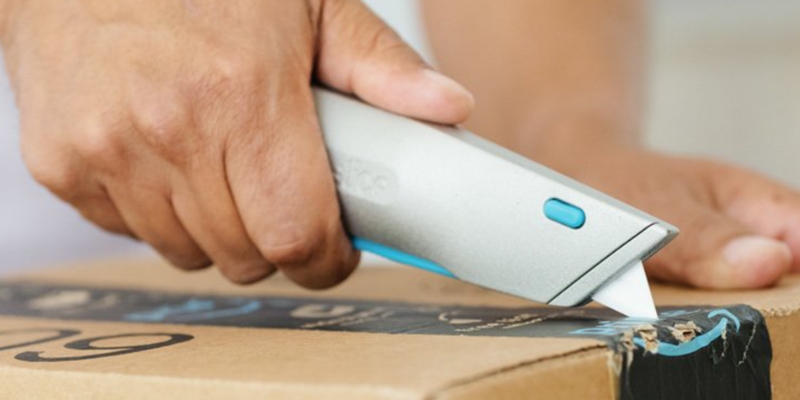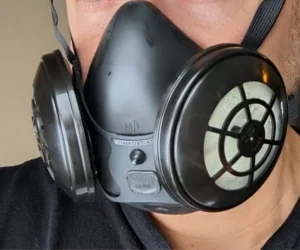Slice makes cutting tools with finger-friendly® blades.
Through collaboration with acclaimed designers, Slice has created safer versions of traditional tools like box cutters, utility knives, precision knives, scissors, and much more.
Slice tools are safer because they’ve redesigned the blade itself. Many people mistakenly believe that a ceramic blade is inherently safer. Let’s set the record straight, the safety feature lies in the design itself, and the material enhances performance.
Using a combination of advanced ceramics with a proprietary double grind, they created a finger-friendly, safe to touch blade with a very effective cutting edge.
Choosing the Right Slice Cutting Tool
When it comes to Slice cutting tools, which include a range of essentials like box cutters, scissors, utility and folding knives, micro-blades, scalpels, precision cutters, scrapers, and deburring tools, finding the perfect tool tailored to your specific needs is key.
This guide is designed to walk you through the considerations unique to Slice tools, ensuring you make an informed choice for your cutting tasks.
Understanding Your Cutting Tool Needs
Begin by clearly defining your cutting requirements. Whether you’re dealing with cardboard, fabric, precision materials, or intricate detailing, different Slice tools cater to distinct needs. Identifying your specific tasks will guide you toward the tool that’s aligns with your application.
Box Cutters:

- Best Applications: Ideal for cutting thin material such as corrugated packaging, cardboard, and plastic film in both industrial and household environments.
- Features: Slice box cutters with ceramic blades have safety features such as limited blade exposure, on-board retraction capability, and an ergonomic handle design.
Choosing the right box cutter depends on the material you’re cutting. Choose a blade length that matches the material you’re working with. Slice box cutters come in a variety of blade depths, so you can find the right tool for the job.
Utility Knives:

- Best Applications: Suitable for cutting corrugated packaging, plastic, and other materials in both industrial and household applications.
- Features: Slice utility knives feature ceramic, finger-friendly blades to prevent lacerations. Most Slice utility knives offer both manual and auto-retractable models.
Slice utility knives and box cutters both use the finger-friendly blades and include many of the same safety features. They differ in the variety of handle designs available and blade lengths.
Utility knives have a longer blade and can cut a broader range of materials. Choose a utility knife that can make a clean cut in one pass with the smallest amount of exposed blade.
Scissors:
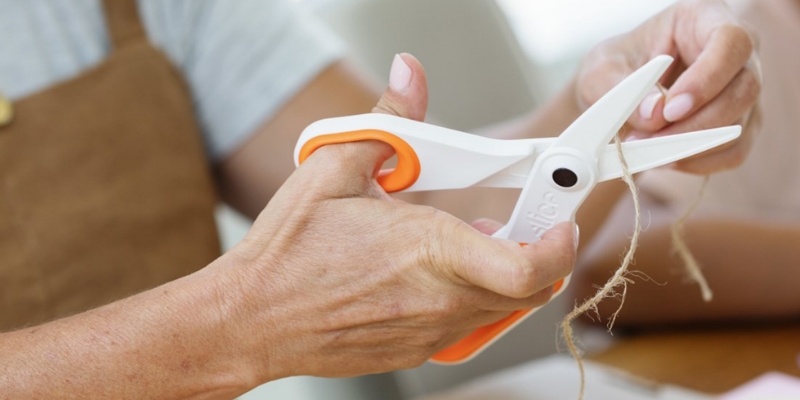
- Best Applications: Versatile for cutting a wide range of materials, including paper, cardstock, felt, plastics, fishing line, thin-gauge copper wire, and more.
- Features: Slice ceramic scissors use 100% advanced ceramics, or zirconium oxide for longevity and performance. These scissor blades are non-sparking, non-conductive, chemically inert, and never rust.
Slice makes four ceramic-blade scissors to choose from: Small Ceramic Scissors (best for children or adults with smaller hands), Large Ceramic Scissors (best for adults), Pointed-Tip Ceramic Scissors (best to start a cut with a puncture), and Self-Opening Ceramic Scissors (shorter blades, best for thread snipping).
Folding Knives:

- Best Applications: Well-suited for outdoor activities such as camping, and for general cutting tasks requiring a portable solution.
- Features: Slice ceramic-blade folding knives are made from 100% zirconium oxide, a very hard material that doesn’t dull quickly. Slice folding knives have nicely weighted, strong, durable handles made from high-quality materials.
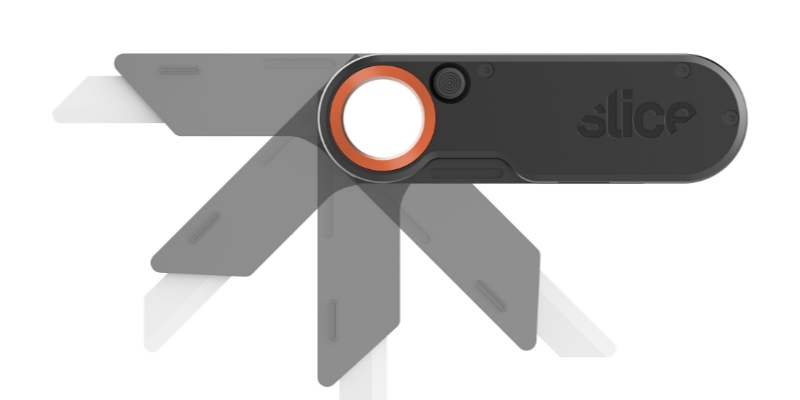
When selecting a folding or pocketknife, safety should be your top concern. Slice folding knives all feature a finger-friendly blade and incorporate several ergonomic handle features.
Micro-Blades & Precision Cutters:

- Best Applications: The smaller cutting surface of micro-blades work well for intricate and precise cutting tasks such as model making, crafting, and detailed work. Micro-blades can be used on paper, plastic film, vinyl, and even clamshell packaging.
- Features: Slice micro-ceramic blades are fixed in place, either embedded in the tool or the blade cartridge. Made from 100% zirconium oxide, the blades are durable and with only a small part of the blade exposed, the change of accidently snapping it off is greatly reduced.
Slice micro-blades are extremely hard, making the thickness of material you’re cutting, the only limitation. For any material thicker than 1.5 millimeters, choose a knife with a greater blade length. Slice tools that use the micro-ceramic blades are the Precision Cutter, the Safety Ring, and the Safety Cutter.
Scalpels:

- Best Applications: Commonly used in laboratory settings for delicate and precise cutting, for precise electronics activity, and working in tight spaces.
- Features: The Slice scalpel features finger-friendly blades, an attachable safety cap, and a textured anti-slip control grip. The durable nylon handle is suitable for industrial use, and it is suitable for both left- and right-hand workers.
When selecting a scalpel, consider a tool that is compatible with multiple blade types and is well-suited to working in tight spaces. The Slice scalpel covers many applications including scraping as it is compatible with craft, seam ripper, and chisel blades.
Scrapers:

- Best Applications: Used in manufacturing, DIY, and home settings for removing adhesives, paint, rust, and smoothing down decals on vehicles or walls.
- Features: Slice ceramic utility scrapers use their finger-friendly blade edge, are safe for scraping high-temperature materials, and ergonomic features such as soft-tough hand grips.
Traditional utility scrapers are made with thin, sharp metal blades, posing a serious injury risk. Look for scrapers with blades made from advanced ceramics and are non-sparking, non-conductive, non-magnetic, chemically inert, and never rust.
Deburring Tools:
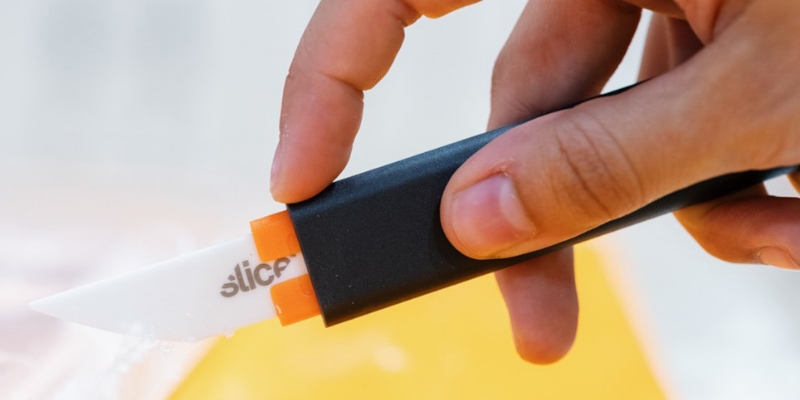
- Best Applications: Great for removing rough edges and burrs from materials post-cutting or machining in industrial settings.
- Features: The Slice deburring tool is lightweight, slim, compatible with convex and concave burring tools, and has a safety cap for added safety.
Deburring tools should be agile, durable, and flexible. Created specifically for the industrial industry, the Slice deburring tool is suitable for both left- and right-handed workers and its blades can be changed quickly and easily.
Key Factors for Choose Any Slice Cutting Tool
Materials and Blade Types:
Evaluate the materials you’ll be cutting and choose a Slice tool with a blade that is safest for your application. By controlling the depth of the exposed blade, you can greatly enhance the safety of your workers and reduce injuries from cuts.
Safety Features:
Prioritize safety with Slice cutting tools that feature finger-friendly blades and ergonomic designs, crucial for reducing the risk of injuries.
Application Environment:
Consider where you’ll be using the tool. Slice tools are versatile, but certain models may be better suited for specific environments, such as those requiring chemical resistance or hygiene standards.
Precision Requirements:
Assess the level of precision needed for your cutting tasks. Slice tools like scalpels and precision cutters are designed explicitly for intricate work that demands accuracy.
User-Friendly Design:
Select Slice tools with designs that align with your comfort preferences. Consider grip style, weight, and ease of handling, especially if tasks require extended use.

Budget Constraints:
While quality is crucial, Slice tools offer a range of options at different price points. Strike a balance between cost and functionality based on your budget constraints.
In the realm of Slice cutting tools, the key to finding the perfect fit lies in understanding the types available, their best applications, and the factors influencing your choice. Whether you’re tackling heavy-duty industrial tasks, precision crafting, or working in a laboratory setting, there’s a Slice tool designed to meet your needs. Armed with this comprehensive guide, you can confidently navigate the diverse world of Slice cutting tools, ensuring each cut is executed with precision, safety, and efficiency.
Dentec Safety is a leading manufacturer and distributor of safety products in the North America since 2004. Dentec Safety is dedicated to providing the highest quality safety products and solutions delivering enhanced value and comfort. Our expertise from decades of experience in Industrial Safety and our innovative design technologies have solidified us as thought leaders in the field. Protection and comfort are at the core of everything we do at Dentec. As a leading manufacturer of Safety Solutions, it is our mission to help organizations do the right thing, keep their employees safe and exceed Industry Health & Safety Standard.

